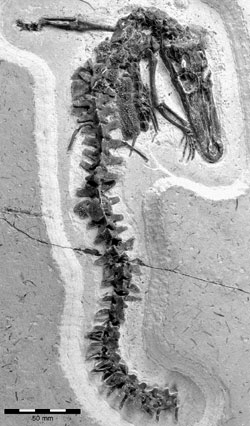Ristevski, J., Weisbecker, V., Scanlon, J.D., Price, G.J. and Salisbury, S.W., 2022. Cranial anatomy of the mekosuchine crocodylian Trilophosuchus rackhami Willis, 1993. The Anatomical Record. DOI: 10.1002/ar.25050.
Ristevski, J., Price, G.J., Weisbecker, V. and Salisbury, S.W. 2021. First record of a tomistomine crocodylian from Australia. Scientific Reports, 11, 12158 (2021). DOI: 10.1038/s41598-021-91717-y
Ristevski, J., Yates, A.M., Price, G.J., Molnar, R.E., Weisbecker, V., Salisbury, S.W. 2020. Australia’s prehistoric ‘swamp king’: revision of the Plio-Pleistocene crocodylian genus Pallimnarchus de Vis, 1886. PeerJ, 8:e10466 DOI 10.7717/peerj.10466
Hart, L.J., Bell, P.R., Smith, E.T., Mitchell, R.D., Broughham, T. and Salisbury, S.W. 2020. A propable skeleton of Isisfordia (Crocodyliformes) and additional crocodyliform remains from the Griman Creek Formation (Cenomanian, New South Wales, Australia). Journal of Paleontology, DOI: 10.1017/jpa.2020.98. 1–16.
Hart, L.J., Bell, P.R., Smith, E.T. and Salisbury, S.W. 2019. Isisfordia molnari sp. nov., a new basal eusuchian from the mid-Cretaceous of Lightning Ridge, Australia. PeerJ. 7:e7166.
Syme, C.E. and Salisbury, S.W. 2018. Taphonomy of Isisfordia duncani specimens from the Lower Cretaceous (upper Albian) portion of the Winton Formation, Isisford, central-west Queensland. Royal Society Open Science. Open Acces
Hanson, J.O., Salisbury, S.W., Campbell, H.A., Dwyer, R.G., Jardine, T.D. and Franklin, C.E. Feeding across the food-web: the interaction between diet, movement, and body size in estuarine crocodiles (Crocodylus porosus). Austral Ecology. (in press)
Syme, C.E. and Salisbury, S.W. 2014. Patterns of aquatic decay and disarticulation in juvenile Indo-Pacific crocodiles (Crocodylus porosus), and implications for the taphonomic interpretation of fossil crocodyliform material. Palaeogeography, Palaeoclimatology, Palaeoecology 421, 108–123. pdf
Salisbury, S.W. and Naish, D. 2011. Crocodilians. Pp. 305–369 in D.J. Batten (ed.) English Wealden fossils. Palaeontological Association Field Guides to Fossils 14. Palaeontological Association, London. 769 pp.
Salisbury, S.W., Holt, T., Worthy, T.H., Sand, C. and Anderson, A. 2010. New material of Mekosuchus inexpectatus (Crocodylia: Mekosuchinae) from the Late Quaternary of New Caledonia, and the phylogenetic relationships of Australasian Cenozoic crocodylians. Journal of Vertebrate Paleontology, 30(Supplement to Number 5): 155A.
Frey, E., and S. W. Salisbury. 2007. Crocodilians of the Crato Formation: evidence for enigmatic species; pp. 463-474, pls 20-21 in D. M. Martill, G. Bechly, and R. F. Loveridge (eds.), The Crato Fossil Beds of Brazil - window into an ancient world. Cambridge University Press, Cambridge.
Salisbury, S. W., Molnar, R. E., Frey, E. & Willis, P. M. A. 2006. The origin of modern crocodyliforms: new evidence from the Cretaceous of Australia. Proceedings of the Royal Society of London, Series B, 273, 2439-2448. pdf, ESM.
Schwarz, D. & Salisbury, S. W. 2005. A new species of Theriosuchus (Atoposauridae, Crocodylomorpha) from the Late Jurassic (Kimmeridgian) of Guimarota, Portugal.Geobios. (in press)
Holt, T. R., Salisbury, S. W. & Willis, P. M. A. 2005. A new species of mekosuchine crocodilian from the Middle Palaeogene Rundle Formation, central Queensland. Memoirs of the Queensland Museum, 50 (2), 212-222.
Salisbury, S. W., Frey, E., Martill, D. M. & Buchy, M.-C. 2003. A new crocodilian from the Lower Cretaceous Crato Formation of north-eastern Brazil. Palaeontographica, Abteilung A (Paläontologie - Stratrigraphie), 270 (1-3), 3-47.
Salisbury, S. W. 2002. Crocodilians from the Lower Cretaceous (Berriasian) Purbeck Limestone Group of Dorset, southern England. In Milner, A. R. (ed). Life and environments of Purbeck times, Special Papers in Palaeontology. The Palaeontological Association, London.
Rossmann, T., Berg, D. E. and Salisbury, S. W. 1999. Studies on Cenozoic crocodiles: 3. Gavialosuchus cf. gaudensis (Eusuchia: Tomistomidae) from the Lower Miocene of south Germany. Neues Jahrbuch für Geologie und Paläontologie, Monatshefte, 1999 (6), 321-330.
Salisbury, S. W., Willis, P. M. A., Peitz, S. and Sander, P. M. 1999. The crocodilian Goniopholis simus from the Lower Cretaceous of north-western Germany. 121-148 In Unwin, D. M. (ed). Cretaceous Fossil Vertebrates, Special Papers in Palaeontology, No. 60. The Palaeontological Association, London.
Salisbury, S. W. and Willis, P. M. A. 1996. A new crocodylian from the Early Eocene of southeastern Queensland and a preliminary investigation of the phylogenetic relationships of crocodyloids. Alcheringa., 20, 179-226.

